Degradation of Steel Rebar Tensile Properties Affected by Longitudinal Non-Uniform Corrosion
Abstract
:1. Introduction
2. Experimental Program
2.1. Specimen Design and Preparation
2.2. Accelerated Corrosion Procedure
2.3. 3D Laser Scanning
2.4. Tensile Testing
3. Corrosion Characteristics
3.1. Corrosion Pattern
3.2. Longitudinal Non-Uniform Corrosion
3.3. Probability Distribution of Cross-Sectional Areas
4. Corrosion Effects on the Tensile Behavior of Steel Rebars
4.1. Nominal Stress–Strain Curve
4.2. Load-Bearing Capacity
4.2.1. Tensile Test Results
4.2.2. Degradation Mechanism
4.2.3. Quantitative Evaluation
4.3. Ductility
4.3.1. Tensile Test Results
4.3.2. Degradation Mechanism
- (1)
- Divide the rebar specimen within its parallel length into n microsegments at an interval of 1 mm, assuming that the cross-sectional area of the ith segment is equal to Ai constantly.
- (2)
- The nonlinear strain–stress relationship of the uncorroded rebar is:
- (3)
- The total deformation of a rebar specimen ∆lj under the tensile load of Fj can then be accumulated by each microsegment as:
- (4)
- Compute the deformation under successive increments of the tensile load; finally, the load-deformation curve can be obtained.
4.3.3. Quantitative Estimation
5. Conclusions
- The corrosion location, range, and localized corrosion levels of embedded rebars were stochastic and longitudinally non-uniform for both pre-cracked and intact RC slabs since they were affected not only by cracks but also by the uneven RC composition and variable environmental conditions. Characterized by the maximum cross-section loss and the variance in the cross-sectional areas, the corrosion non-uniformity along the length of the rebar increases with the increasing average corrosion degrees.
- The probability distribution of cross-sectional areas for uncorroded and slightly corroded rebars was generally unimodal. As the average corrosion degree increased, it changed from symmetrical to left-skewed. When the average volume loss was greater than 20%, a multimodal distribution for the cross-sectional areas could be observed.
- The corrosion level affects the nominal stress–strain curves of the corroded steel rebars in terms of the yield limit, ultimate limit, and yield plateau. On the other hand, corrosion non-uniformity also has non-negligible effects on it; differences were found between corroded rebars with similar average corrosion levels, especially around the point of ultimate limit.
- The yield and ultimate load decreased linearly with an increase in the average volume loss. However, corrosion did not weaken the effective yield and ultimate strength calculated on the minimum residual cross-sectional areas. The strengthening effect resulting from corrosion pits even slightly increased the effective strength of the corroded rebars. The main cause of the load-bearing capacity degradation of corroded rebars is the loss of the effective critical cross-section, and the nominal strength of the steel rebars is dominated by the critical cross-sectional areas. Thus, by considering the longitudinal non-uniform corrosion, it is more accurate to adopt the maximum cross-section loss instead of the average corrosion degree to estimate the corroded rebars’ degraded load-bearing capacity.
- The ultimate strain and elongation after fracture decreased exponentially with an increase in average volume loss. The degradation models based on the maximum cross-section loss were found to be better correlated with the test results than those based on the average volume loss. The ductility of the corroded rebars decreased more rapidly and was affected by more factors compared with the load-bearing capacity. Cross-sectional loss along the entire length of the rebar is the primary cause of ductility degradation. The mechanical properties of steel are unaffected.
- From the numerical calculation of corroded rebars based on the mechanical properties of the uncorroded rebar and scanning the cross-sectional areas of the corroded rebar, the calculation of load-deformation curves agreed with the test curves. Normal distribution models, in which the mean and variance are equivalent to practical values, were proposed to simulate the cross-sectional areas of corroded rebars for numerical analysis.
Author Contributions
Funding
Institutional Review Board Statement
Informed Consent Statement
Data Availability Statement
Acknowledgments
Conflicts of Interest
Notations
| Yield load of uncorroded rebar | Average volume loss | ||
| Ultimate load of uncorroded rebar | Average cross-section loss | ||
| Yield load of corroded rebar | Maximum cross-section loss | ||
| Ultimate load of corroded rebar | Average cross-sectional areas of uncorroded rebar | ||
| Yield strength of uncorroded rebar | Minimum cross-sectional areas of uncorroded rebar | ||
| Ultimate strength of uncorroded rebar | Average cross-sectional areas of corroded rebar | ||
| Yield strength of corroded rebar | Minimum cross-sectional areas of corroded rebar | ||
| Ultimate strength of corroded rebar | Volume of uncorroded rebar | ||
| Ultimate strain of uncorroded rebar | Volume of corroded rebar | ||
| Ultimate strain of corroded rebar | Parallel length of tensile rebar | ||
| Elongation after fracture of uncorroded rebar | Nominal yield strength (Fy/An) | ||
| Elongation after fracture of corroded rebar | Nominal ultimate strength (Fu/An) | ||
| Deformation at maximum load | Effective yield strength (Fy/Amin) | ||
| Average corrosion degree (mass or volume loss) | Effective ultimate strength (Fu/Amin) | ||
| Nominal (original) diameter | Stress | ||
| Nominal (original) cross-sectional areas | Strain | ||
| Elastic modulus of uncorroded rebar |
References
- Otieno, M.; Ikotun, J.; Ballim, Y. Experimental investigations on the influence of cover depth and concrete quality on time to cover cracking due to carbonation-induced corrosion of steel in RC structures in an urban, inland environment. Constr. Build. Mater. 2019, 198, 172–181. [Google Scholar] [CrossRef]
- Zhang, L.; Niu, D.; Wen, B.; Luo, D. Concrete Protective Layer Cracking Caused by Non-Uniform Corrosion of Reinforcements. Materials 2019, 12, 4245. [Google Scholar] [CrossRef] [PubMed] [Green Version]
- Chai, X.; Shang, H.; Zhang, C. Bond behavior between corroded steel bar and concrete under sustained load. Constr. Build. Mater. 2021, 310, 125122. [Google Scholar] [CrossRef]
- Shang, H.; Zhou, J.; Yang, G. Study on the bond behavior of corroded steel bars embedded in concrete under the coupled effect of reciprocating loads and chloride ion erosion. Constr. Build. Mater. 2021, 305, 124658. [Google Scholar] [CrossRef]
- Crespi, P.; Zucca, M.; Valente, M.; Longarini, N. Influence of corrosion effects on the seismic capacity of existing RC bridges. Eng. Fail. Anal. 2022, 140, 106546. [Google Scholar] [CrossRef]
- Daneshvar, K.; Moradi, M.J.; Ahmadi, K.; Mahdavi, G.; Hariri-Ardebili, M.A. Dynamic behavior of corroded RC slabs with macro-level stochastic finite element simulations. Eng. Struct. 2021, 239, 112056. [Google Scholar] [CrossRef]
- Angst, U.M. Challenges and opportunities in corrosion of steel in concrete. Mater. Struct. 2018, 51, 4. [Google Scholar] [CrossRef] [Green Version]
- Apostolopoulos, C.A.; Demis, S.; Papadakis, V.G. Chloride-induced corrosion of steel reinforcement—Mechanical performance and pit depth analysis. Constr. Build. Mater. 2013, 38, 139–146. [Google Scholar] [CrossRef]
- Vanama, R.K.; Ramakrishnan, B. Improved degradation relations for the tensile properties of naturally and artificially corroded steel rebars. Constr. Build. Mater. 2020, 249, 118706. [Google Scholar] [CrossRef]
- Zhang, W.; Chen, H.; Gu, X. Tensile behaviour of corroded steel bars under different strain rates. Mag. Concr. Res. 2016, 68, 127–140. [Google Scholar] [CrossRef]
- Zhang, J.; Huang, J.; Fu, C.; Huang, L.; Ye, H. Characterization of steel reinforcement corrosion in concrete using 3D laser scanning techniques. Constr. Build. Mater. 2021, 270, 121402. [Google Scholar] [CrossRef]
- Tang, F.; Lin, Z.; Chen, G.; Yi, W. Three-dimensional corrosion pit measurement and statistical mechanical degradation analysis of deformed steel bars subjected to accelerated corrosion. Constr. Build. Mater. 2014, 70, 104–117. [Google Scholar] [CrossRef]
- Cairns, J.; Plizzari, G.A.; Du, Y.; Law, D.W.; Franzoni, C. Mechanical Properties of Corrosion-Damaged Reinforcement. ACI Mater. J. 2005, 102, 256. [Google Scholar] [CrossRef]
- Imperatore, S.; Rinaldi, Z.; Drago, C. Degradation relationships for the mechanical properties of corroded steel rebars. Constr. Build. Mater. 2017, 148, 219–230. [Google Scholar] [CrossRef]
- Kashani, M.M.; Crewe, A.J.; Alexander, N.A. Nonlinear stress–strain behaviour of corrosion-damaged reinforcing bars including inelastic buckling. Eng. Struct. 2013, 48, 417–429. [Google Scholar] [CrossRef]
- Lee, H.; Cho, Y. Evaluation of the mechanical properties of steel reinforcement embedded in concrete specimen as a function of the degree of reinforcement corrosion. Int. J. Fract. 2009, 157, 81–88. [Google Scholar] [CrossRef]
- Lu, C.; Yuan, S.; Cheng, P.; Liu, R. Mechanical properties of corroded steel bars in pre-cracked concrete suffering from chloride attack. Constr. Build. Mater. 2016, 123, 649–660. [Google Scholar] [CrossRef]
- Ou, Y.; Susanto, Y.T.T.; Roh, H. Tensile behavior of naturally and artificially corroded steel bars. Constr. Build. Mater. 2016, 103, 93–104. [Google Scholar] [CrossRef]
- Sun, X.; Kong, H.; Wang, H.; Zhang, Z. Evaluation of corrosion characteristics and corrosion effects on the mechanical properties of reinforcing steel bars based on three-dimensional scanning. Corros. Sci. 2018, 142, 284–294. [Google Scholar] [CrossRef]
- Xia, J.; Jin, W.; Zhao, Y.; Li, L. Mechanical performance of corroded steel bars in concrete. Struct. Build. 2013, 166, 235–246. [Google Scholar] [CrossRef]
- Gao, Y.; Zheng, Y.; Zhang, J.; Xu, S.; Zhou, X.; Zhang, Y. Time-dependent corrosion process and non-uniform corrosion of reinforcement in RC flexural members in a tidal environment. Constr. Build. Mater. 2019, 213, 79–90. [Google Scholar] [CrossRef]
- Yu, Y.; Gao, W.; Castel, A.; Liu, A.; Feng, Y.; Chen, X.; Mukherjee, A. Modelling steel corrosion under concrete non-uniformity and structural defects. Cem. Concr. Res. 2020, 135, 106109. [Google Scholar] [CrossRef]
- Gao, X.; Pan, Y.; Ren, X. Probabilistic model of the minimum effective cross-section area of non-uniform corroded steel bars. Constr. Build. Mater. 2019, 216, 227–238. [Google Scholar] [CrossRef]
- Wang, X.; Song, X.; Zhang, M.; Du, X. Experimental comparison of corrosion unevenness and expansive cracking between accelerated corrosion methods used in laboratory research. Constr. Build. Mater. 2017, 153, 36–43. [Google Scholar] [CrossRef]
- Li, D.; Xiong, C.; Huang, T.; Wei, R.; Han, N.; Xing, F. A simplified constitutive model for corroded steel bars. Constr. Build. Mater. 2018, 186, 11–19. [Google Scholar] [CrossRef]
- Angst, U.M. Predicting the time to corrosion initiation in reinforced concrete structures exposed to chlorides. Cem. Concr. Res. 2019, 115, 559–567. [Google Scholar] [CrossRef]
- Colak, H.; Soyoz, S. Time-dependent seismic performance assessment of RC buildings exposed to corrosion. Structures 2023, 47, 1134–1147. [Google Scholar] [CrossRef]
- Jiang, H.; Jin, N.; Ye, H.; Tian, Y.; Jin, X.; Zeng, Q.; Yan, D.; Xu, X. Fractal Characterization of Non-Uniform Corrosion of Steel Bars in Concrete Beams after Accelerated depassivation and Seven-Year Natural Corrosion. Materials 2019, 12, 3919. [Google Scholar] [CrossRef] [Green Version]
- Zhao, J.; Lin, Y.; Li, X.; Meng, Q. Experimental study on the cyclic behavior of reinforced concrete bridge piers with non-uniform corrosion. Structures 2021, 33, 999–1006. [Google Scholar] [CrossRef]
- Finozzi, I.; Saetta, A.; Budelmann, H. Structural response of reinforcing bars affected by pitting corrosion: Experimental evaluation. Constr. Build. Mater. 2018, 192, 478–488. [Google Scholar] [CrossRef]
- Zhou, B.; Sun, X.; Zou, D.; Wang, H. Evaluation of corrosion morphology on mechanical properties of reinforcing steel bars using numerical simulation and simplified analytical model. J. Build. Eng. 2022, 52, 104380. [Google Scholar] [CrossRef]
- Zhang, W.; Li, C.; Gu, X.; Dai, H. Stochastic model of constitutive relationship for corroded steel bars. J. Build. Mater. 2014, 17, 920–926. [Google Scholar]
- Wang, Y.; Zhou, X.; Wang, H.; Kong, D.; Xu, S. Stochastic constitutive model of structural steel based on random field of corrosion depth. Case Stud. Constr. Mater. 2022, 16, e00972. [Google Scholar] [CrossRef]
- Melchers, R. Structural Rebility Analysis and Prediction; Wiley & Sons: Chichester, UK, 2002. [Google Scholar]
- Sokołowski, D.; Kamiński, M. Stochastic Reliability-Based Design Optimization Framework for the Steel Plate Girder with Corrugated Web Subjected to Corrosion. Materials 2022, 15, 7170. [Google Scholar] [CrossRef] [PubMed]
- GB/T 50152-2012; Standard for Test Method of Concrete Structures. National Standard of the People’s Republic of China: Beijing, China, 2012.
- Qiao, D.; Nakamura, H.; Yamamoto, Y.; Miura, T. Evaluation Method of Tensile Behavior of Corroded Reinforcing Bars Considering Radius Loss. J. Adv. Concr. Technol. 2015, 13, 135–146. [Google Scholar] [CrossRef] [Green Version]
- GB/T 228.1-2010; Metallic Materials-Tensile Testing-Part 1: Method of Test at Room Temperature (ISO 6892-1: 2009, MOD). National Standard of the People’s Republic of China: Beijing, China, 2010.
- Chen, J.; Zhang, W.; Gu, X. Modeling time-dependent circumferential non-uniform corrosion of steel bars in concrete considering corrosion-induced cracking effects. Eng. Struct. 2019, 201, 109766. [Google Scholar] [CrossRef]
- Jiang, H.; Tian, Y.; Jin, N.; Jin, X.; Tian, Z.; Yan, D.; Ye, H. Effect of aggregates spatial distribution on three-dimensional transport of chloride ions in reinforced concrete. Constr. Build. Mater. 2020, 259, 119694. [Google Scholar] [CrossRef]
- Zhao, Y.; Xu, X.; Wang, Y.; Dong, J. Characteristics of pitting corrosion in an existing reinforced concrete beam exposed to marine environment. Constr. Build. Mater. 2020, 234, 117392. [Google Scholar] [CrossRef]
- Dong, J.; Zhao, Y.; Wang, K.; Jin, W. Crack propagation and flexural behaviour of RC beams under simultaneous sustained loading and steel corrosion. Constr. Build. Mater. 2017, 151, 208–219. [Google Scholar] [CrossRef]
- Xu, G.; Zhang, D.; Liu, D.; Jun, W. Research on mechanical properties of corroded steel bar in concrete under chloride environment. J. Hydraul. Eng. 2012, 43, 452–459. [Google Scholar] [CrossRef]
- Liu, J.; Luo, X.; Xiao, Y. Non-uniform corrosion and distribution models of residual cross-sectional areas of rebars. J. Huazhong Univ. Sci. Technol. (Nat. Sci. Ed.) 2021, 49, 83–88. [Google Scholar] [CrossRef]
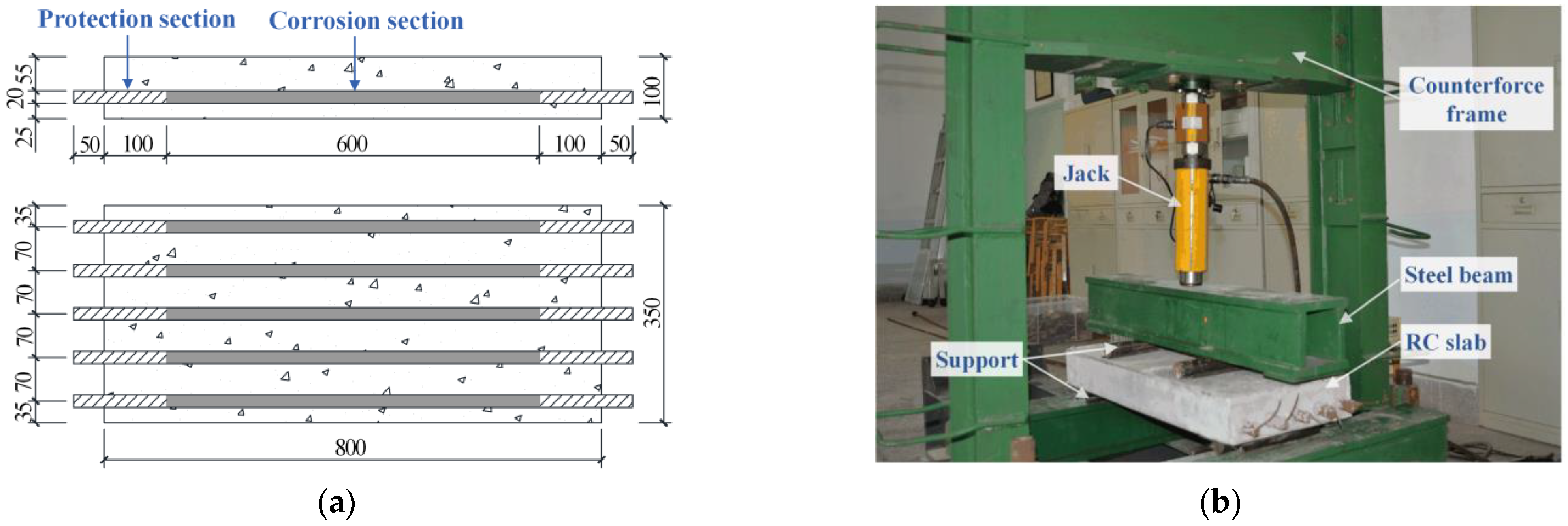
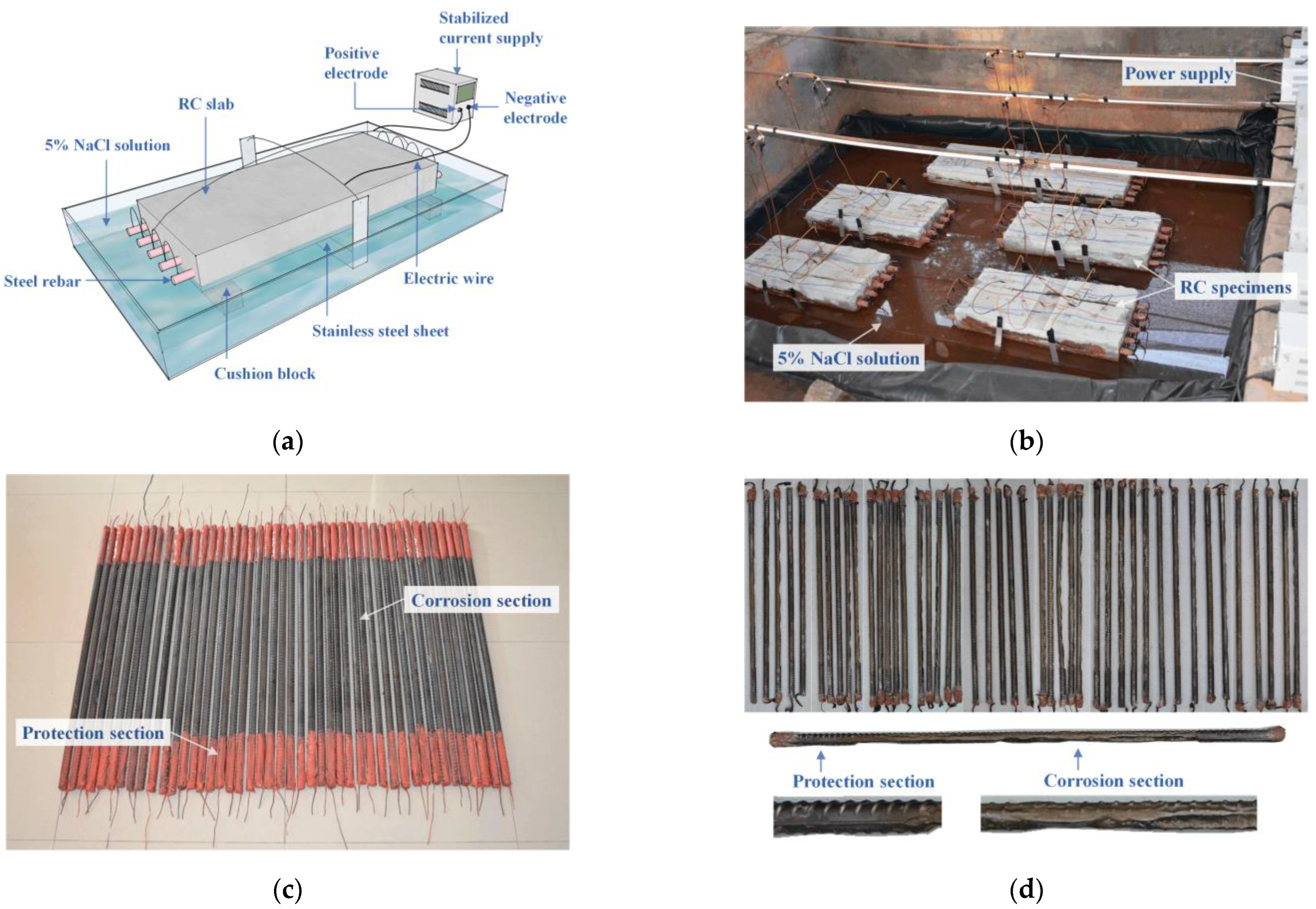
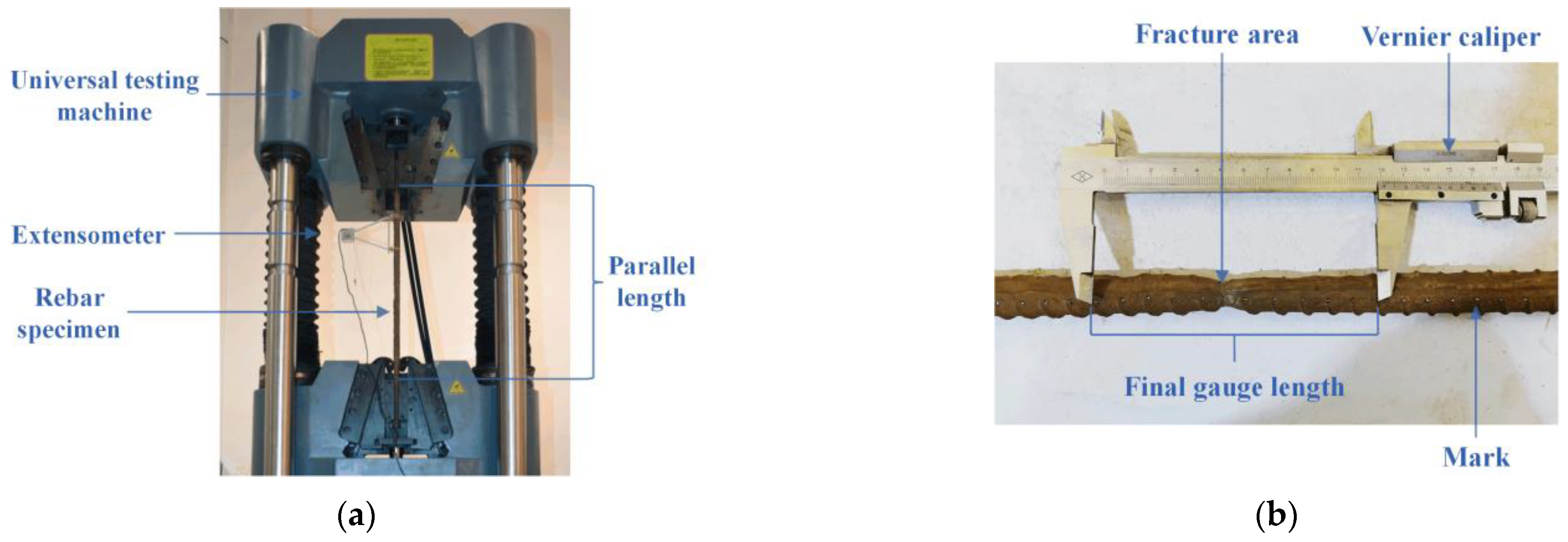


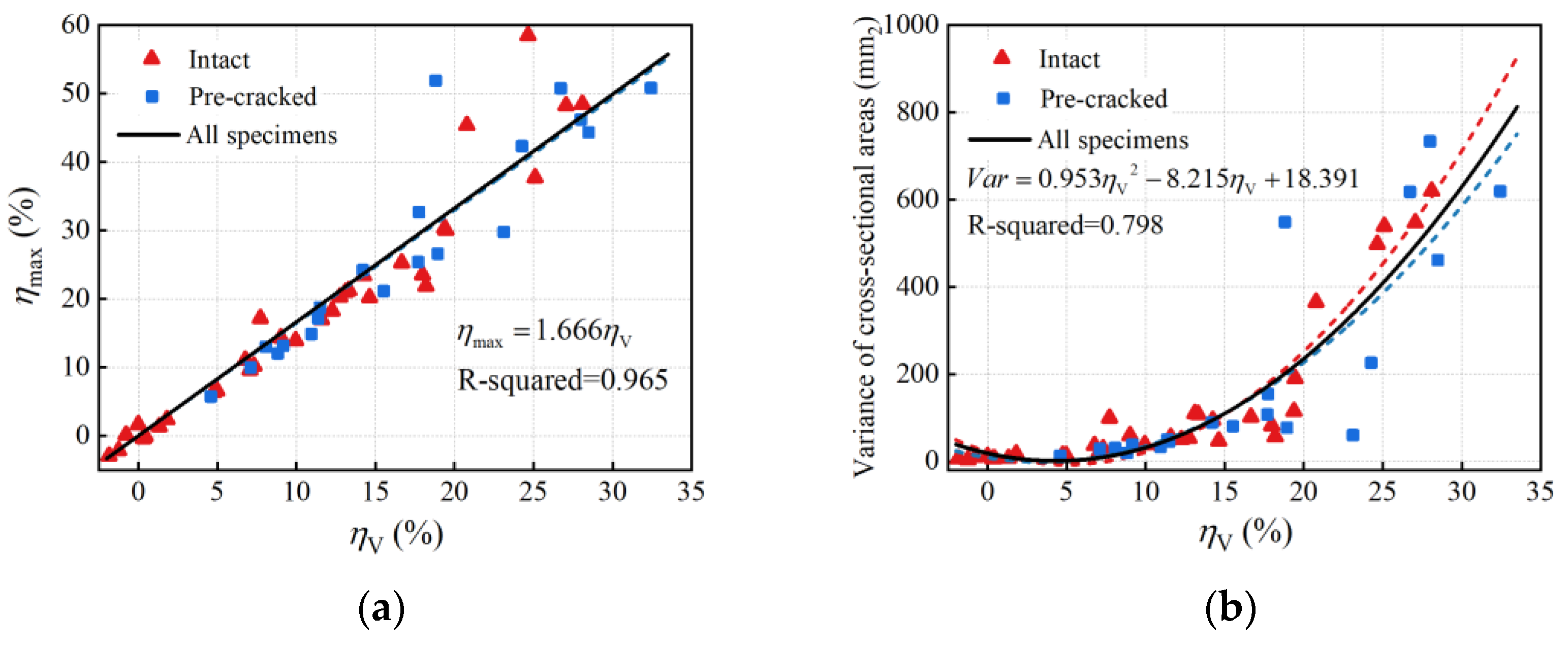
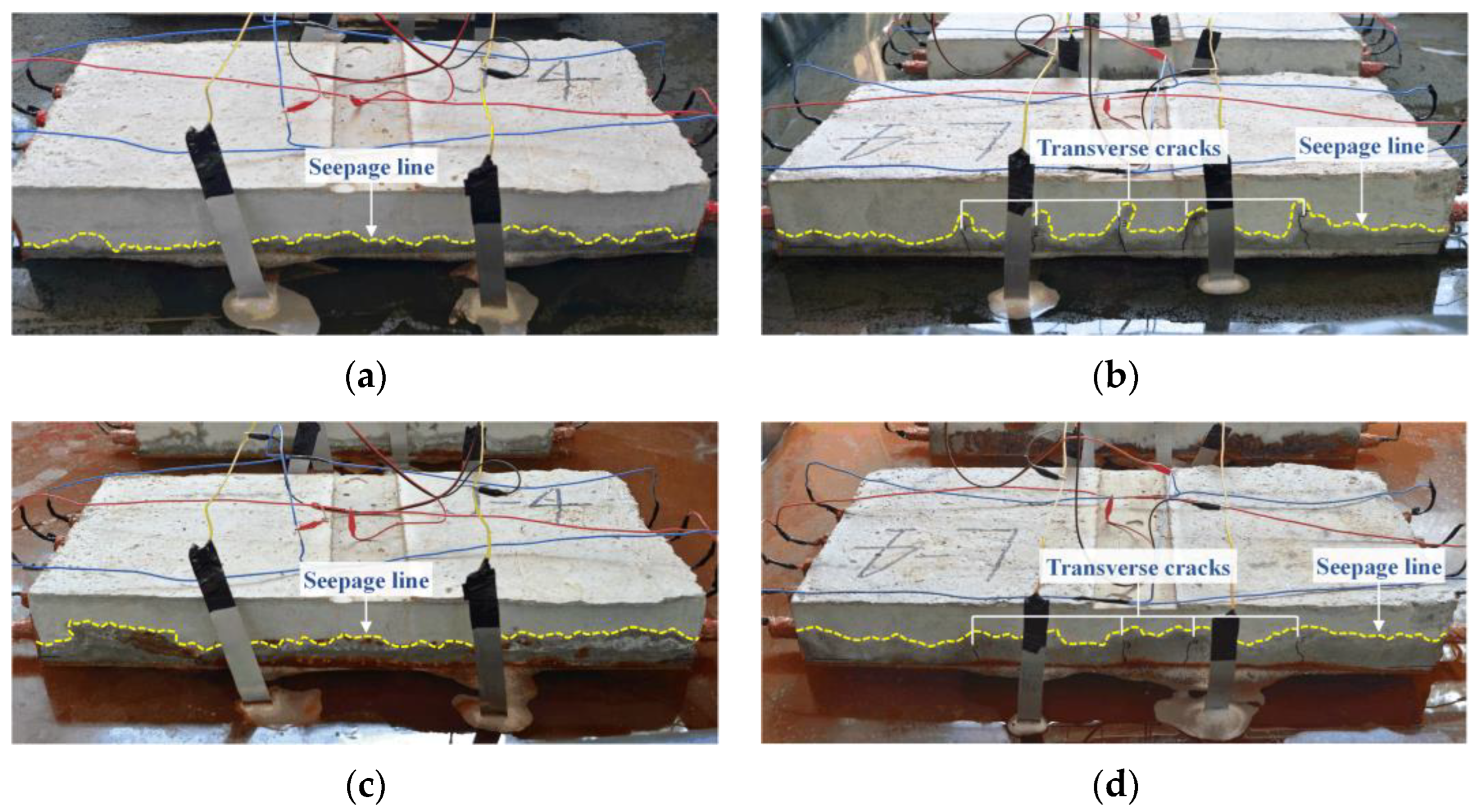

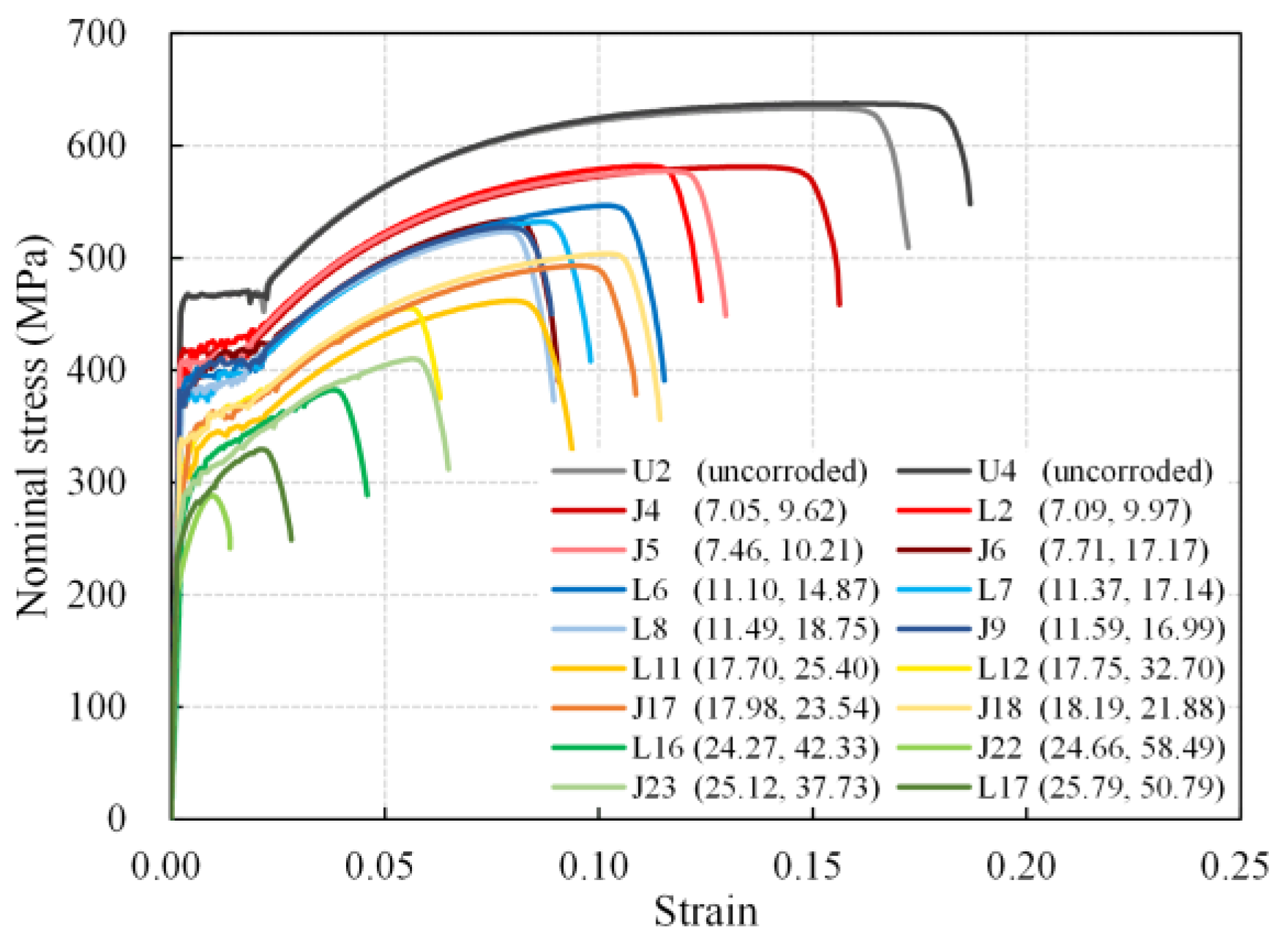
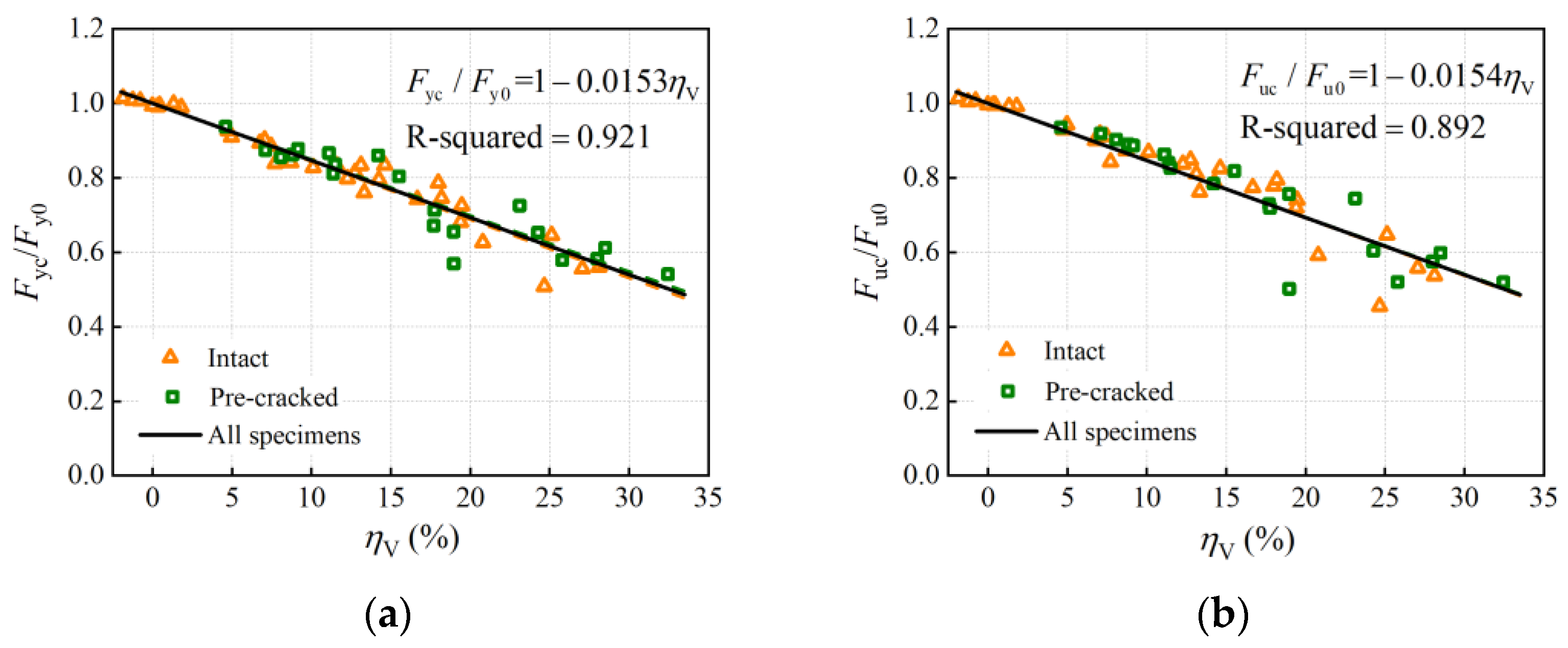
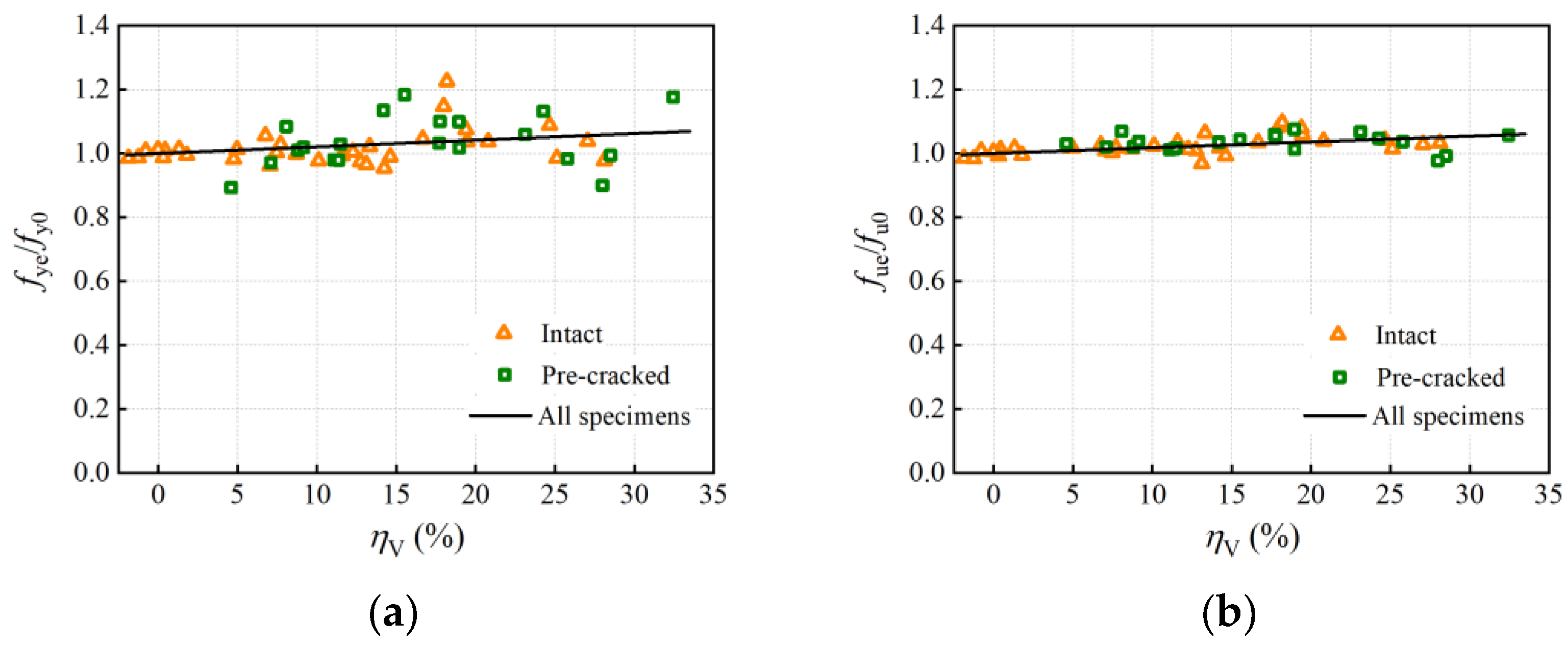

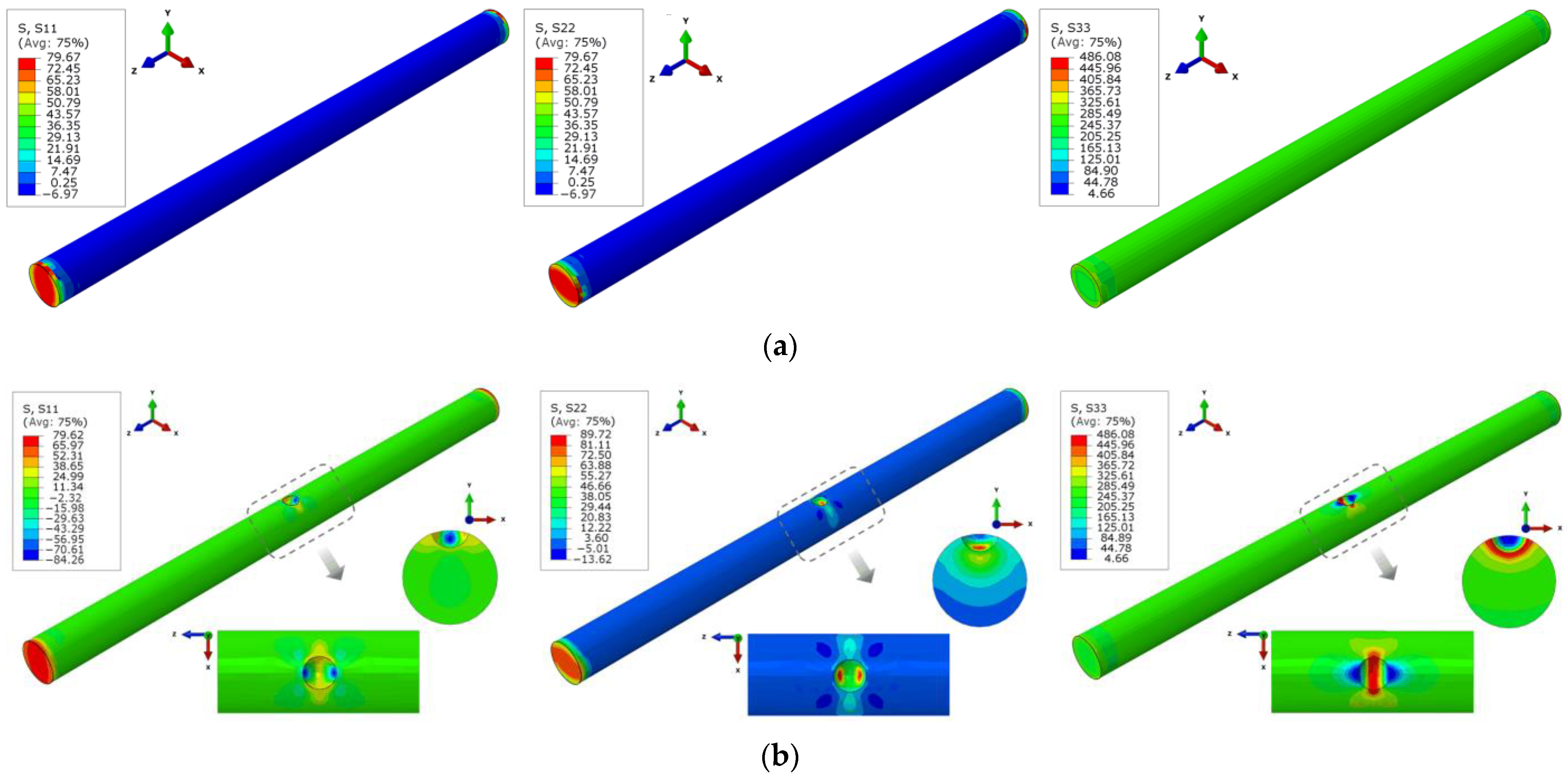
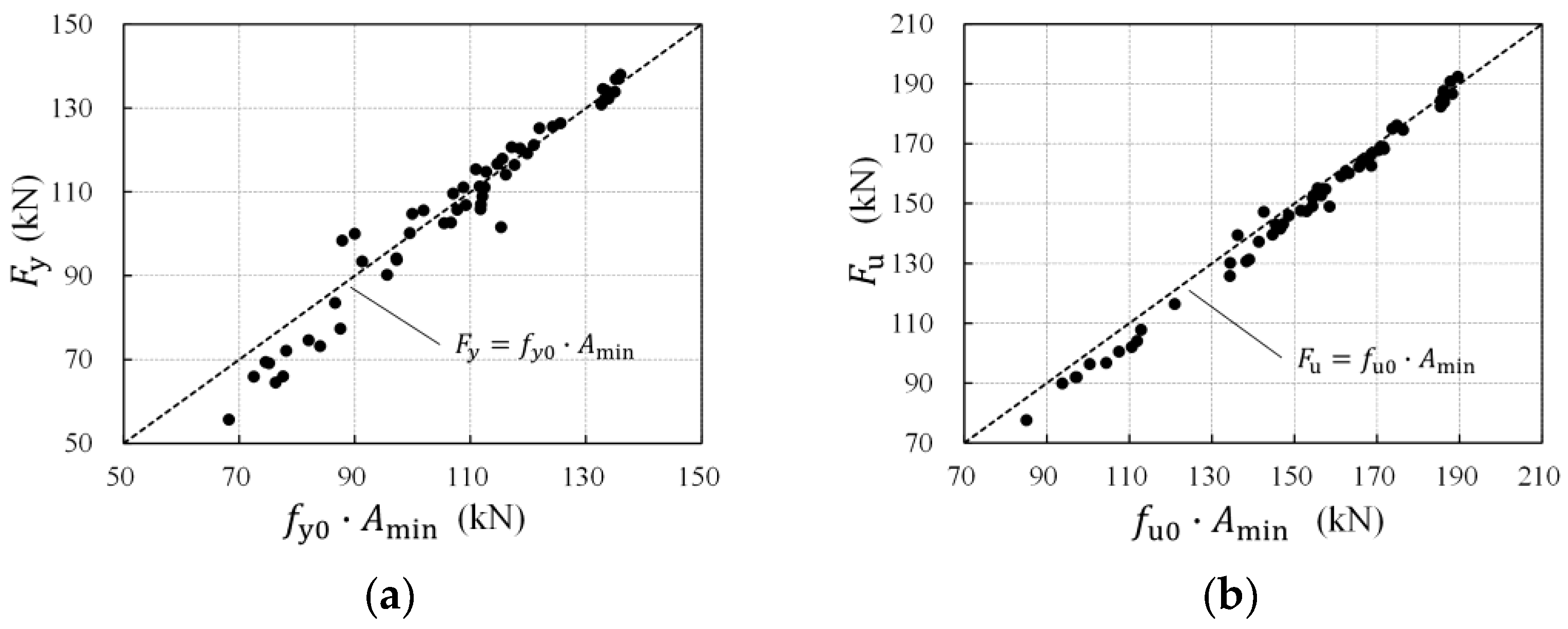
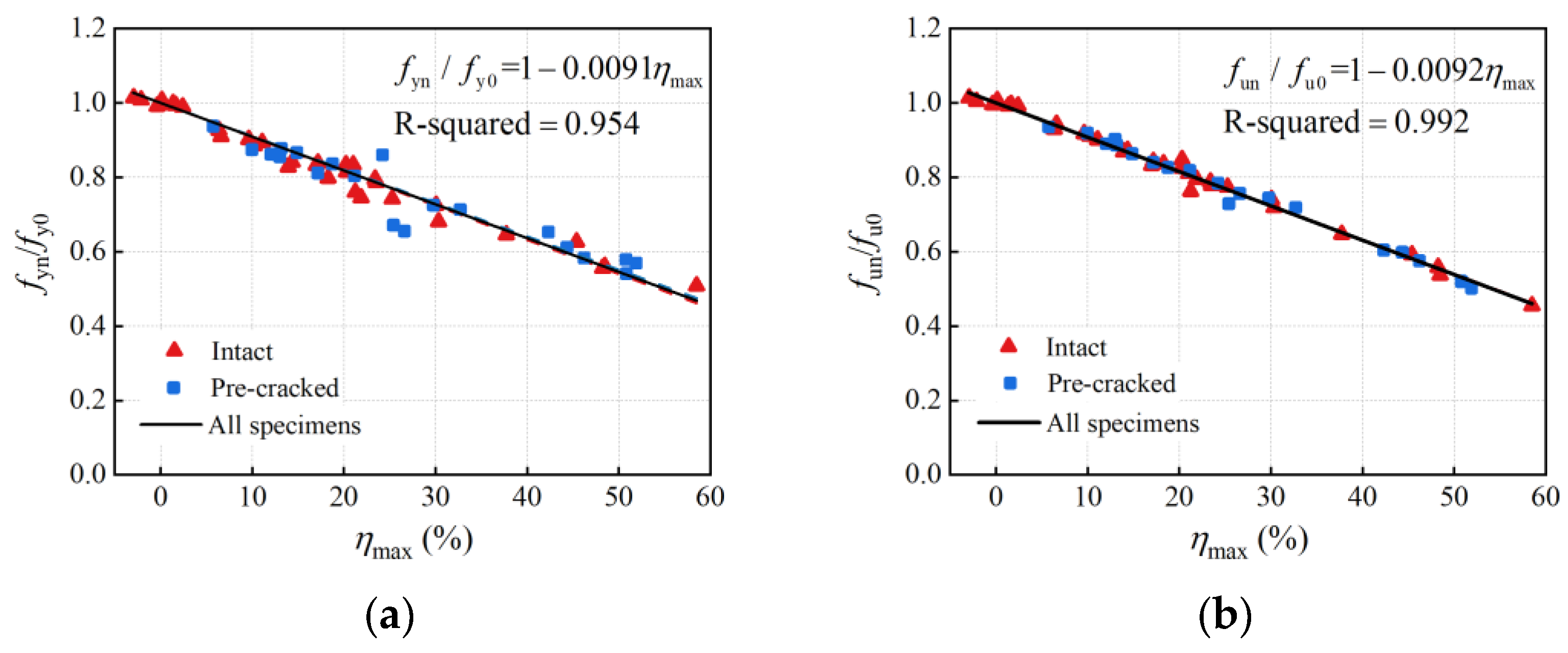


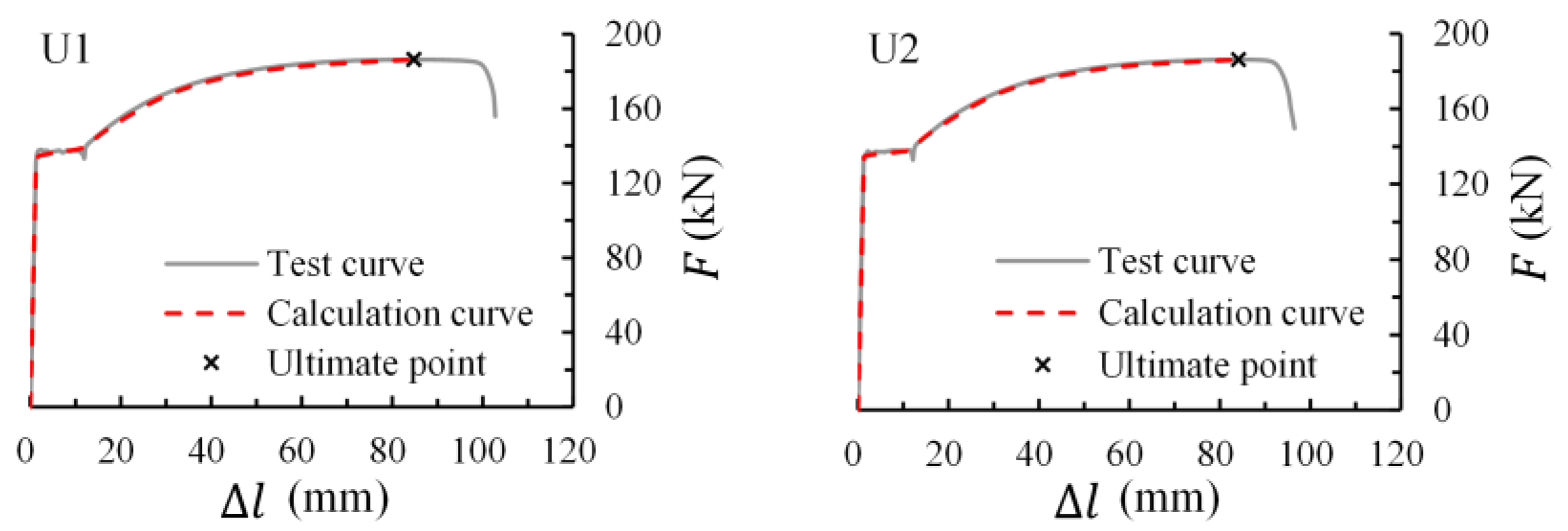
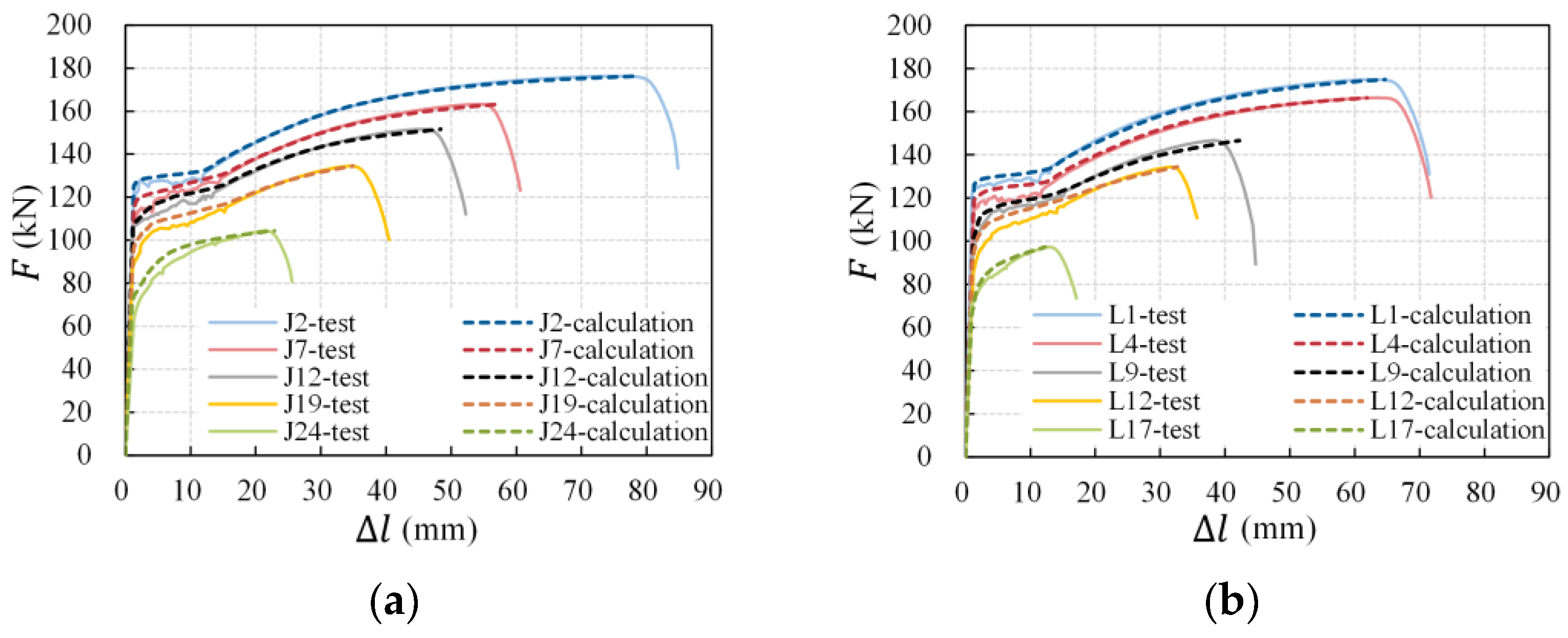
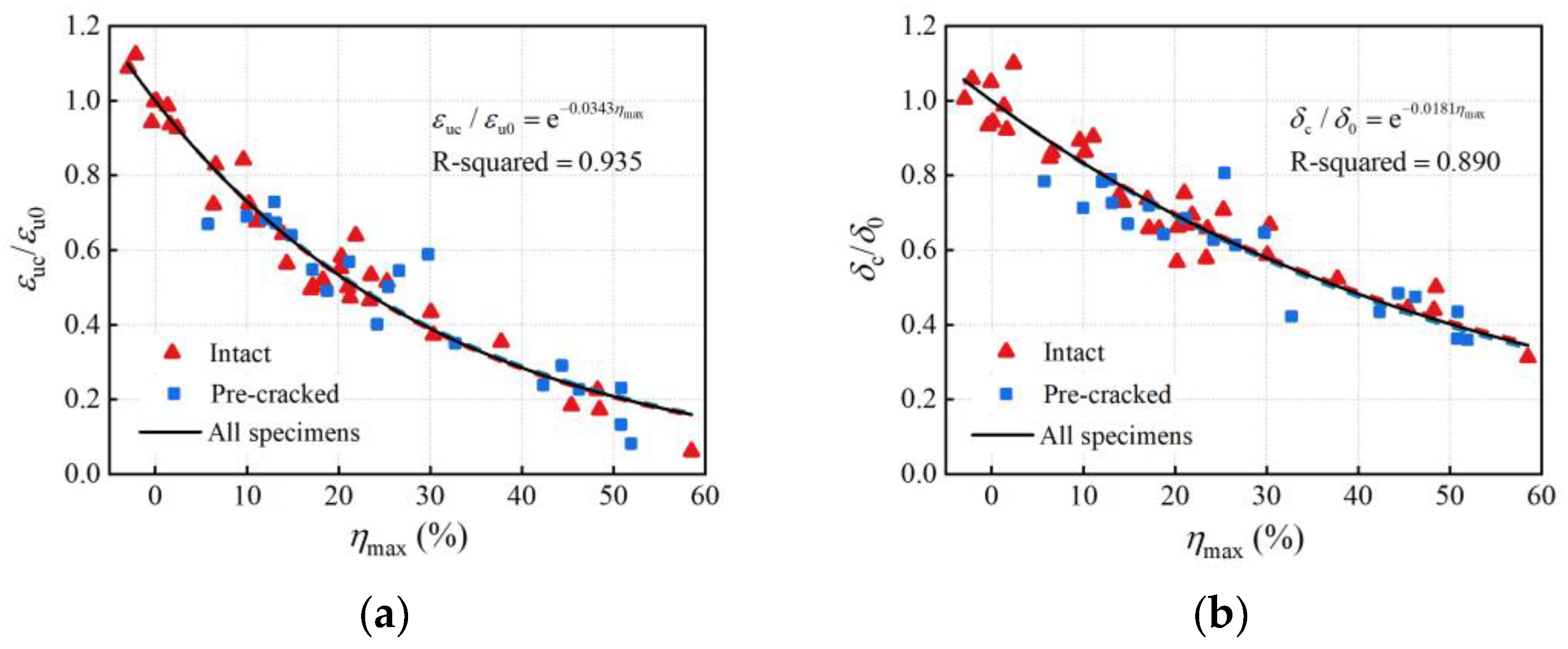
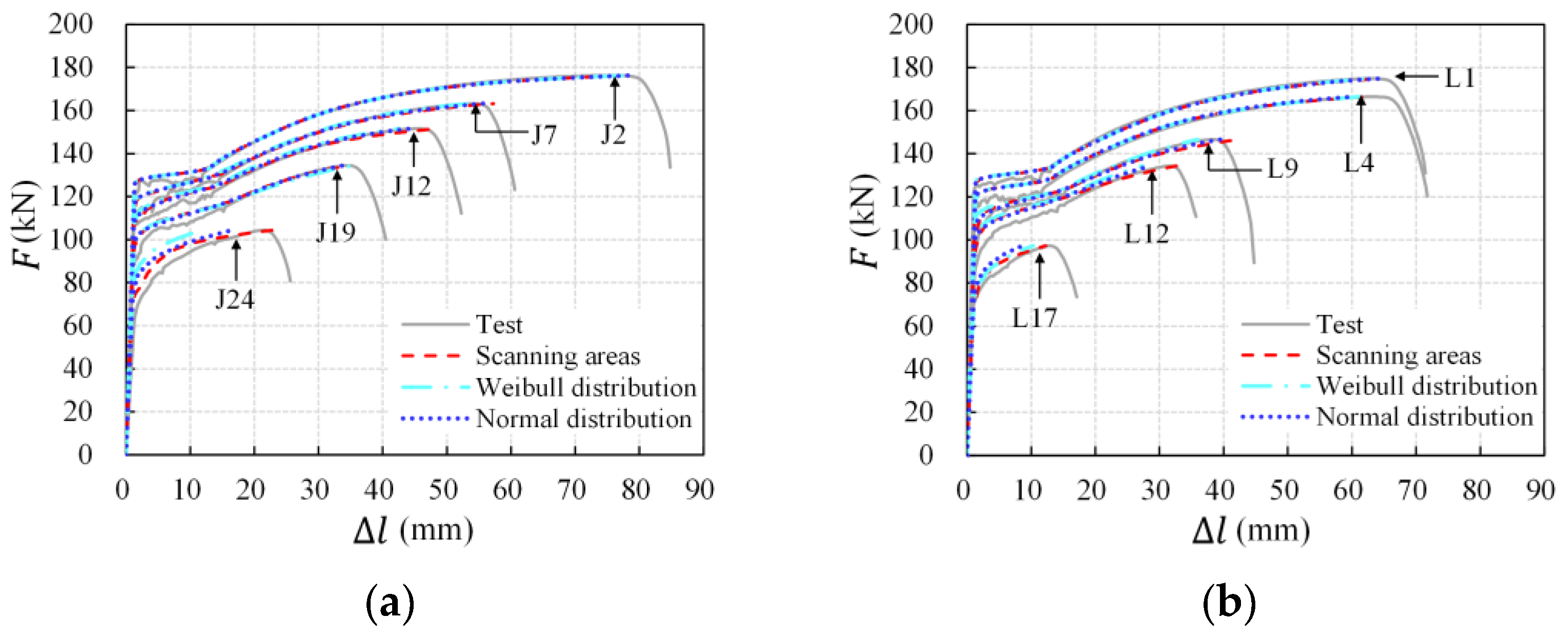
| Author | Diameter (mm) | Specimens Condition | Corrosion Process | Degradation of Load-Bearing Capacity | Degradation of Ductility |
|---|---|---|---|---|---|
| Vanama et al. [9] | Φ12.7 (MS 250, MS 350) | Bars in concrete | Natural (Service) | ||
| Ou et al. [18] | D13, D16, D19 | Bars in concrete | Natural (Service) | ||
| Lee and Cho [16] | D10, D13 (SD295A) | Bars in concrete | Artificial (Wet and Dry) | ||
| Lu et al. [17] | D16 (HRB400) | Bars in concrete | Artificial (Wet and Dry) | ||
| Cairns et al. [13] | Φ16 | Bars in concrete | Electrical (Wet and Dry) | ||
| Tang et al. [12] | D19.1 (Grand420) | Bars in concrete | Electrical (Salt spray) | ||
| Ou et al. [18] | D13, D29 (A706) | Bars in concrete | Electrical (Full-immersed) | ||
| Lee and Cho [16] | D13 (SD295A, SD345D) | Bars in concrete | Electrical (Full-immersed) | ||
| Kashani et al. [15] | D8, D12 (B500B, B500) | Bars in concrete | Electrical (Full-immersed) | N/S | |
| Zhang et al. [10] | N/S (HPB235, HRB335, HRB400) | Bars in concrete | Electrical (Half-immersed) | ||
| Xia et al. [20] | D16, D20 (HRB335, HRB500) | Bars in concrete | Electrical | ||
| Sun et al. [19] | D14, D16 (HRB400, HRB500) | Bare bars on wet sponge | Electrical | ||
| Xia et al. [20] | Φ6, Φ8, Φ10 D12, D14, D16, D20 | Bare bars on wet sponge | Electrical | ||
| Vanama et al. [9] | D16 (Fe 500D) | Bare bars | Electrical (Half-immersed) | N/S | |
| Imperatore et al. [14] | D8, D12, D16, D20 (S500C) | Bare bars | Electrical (Half-immersed) |
| dn (mm) | fy0 (MPa) | fu0 (MPa) | E0 (MPa) | εu0 | δ0 |
|---|---|---|---|---|---|
| 20 | 465.00 | 648.17 | 2.02 × 105 | 0.159 | 0.254 |
| No. | ηV (%) | ηavg (%) | ηmax (%) | No. | ηV (%) | ηavg (%) | ηmax (%) |
|---|---|---|---|---|---|---|---|
| U1 | −0.01 | 0.10 | 1.65 | J1 | 4.75 | 4.86 | 6.35 |
| U2 | 0.32 | 0.44 | −0.38 | J2 | 4.96 | 5.07 | 6.59 |
| U3 | 0.43 | 0.54 | −0.07 | J3 | 6.76 | 6.86 | 11.08 |
| U4 | 1.32 | 1.43 | 1.35 | J4 | 7.05 | 7.15 | 9.62 |
| U5 | 1.80 | 1.91 | 2.40 | J5 | 7.46 | 7.41 | 10.21 |
| U6 | −1.86 | −2.11 | −2.94 | J6 | 7.71 | 7.81 | 17.17 |
| U7 | −1.25 | −1.24 | −2.13 | J7 | 8.70 | 9.11 | 14.35 |
| U8 | −0.79 | −1.07 | 0.12 | J8 | 10.11 | 10.04 | 13.92 |
| L1 | 4.59 | 4.70 | 5.73 | J9 | 11.59 | 11.68 | 16.99 |
| L2 | 7.09 | 7.19 | 9.97 | J10 | 12.26 | 12.35 | 18.28 |
| L3 | 8.07 | 8.17 | 12.99 | J11 | 12.75 | 12.84 | 20.30 |
| L4 | 8.81 | 8.91 | 12.03 | J12 | 13.11 | 13.21 | 21.02 |
| L5 | 9.15 | 9.26 | 13.15 | J13 | 13.32 | 13.40 | 21.25 |
| L6 | 11.10 | 11.04 | 14.87 | J14 | 14.24 | 14.34 | 23.41 |
| L7 | 11.37 | 11.47 | 17.14 | J15 | 14.62 | 14.72 | 20.22 |
| L8 | 11.49 | 11.59 | 18.75 | J16 | 16.66 | 16.75 | 25.28 |
| L9 | 14.20 | 14.30 | 24.22 | J17 | 17.98 | 18.07 | 23.54 |
| L10 | 15.51 | 15.61 | 21.15 | J18 | 18.19 | 18.28 | 21.88 |
| L11 | 17.70 | 17.79 | 25.40 | J19 | 19.39 | 19.47 | 30.35 |
| L12 | 17.75 | 17.83 | 32.70 | J20 | 19.46 | 19.54 | 30.06 |
| L13 | 18.96 | 18.90 | 51.91 | J21 | 20.79 | 20.87 | 45.40 |
| L14 | 18.95 | 19.03 | 26.60 | J22 | 24.66 | 24.73 | 58.49 |
| L15 | 23.11 | 23.20 | 29.78 | J23 | 25.12 | 25.18 | 37.73 |
| L16 | 24.27 | 24.35 | 42.33 | J24 | 27.06 | 27.14 | 48.25 |
| L17 | 25.79 | 26.80 | 50.79 | J25 | 28.11 | 28.17 | 48.47 |
| L18 | 28.00 | 28.07 | 46.22 | ||||
| L19 | 28.50 | 28.57 | 44.35 | ||||
| L20 | 32.45 | 32.51 | 50.83 |
| No. | ηV (%) | fyn (MPa) | fun (MPa) | εuc | No. | ηV (%) | fyn (MPa) | fun (MPa) | εuc |
|---|---|---|---|---|---|---|---|---|---|
| J4 | 7.05 | 410.35 | 581.84 | 0.134 | L11 | 17.70 | 305.32 | 462.26 | 0.080 |
| L2 | 7.09 | 397.49 | 582.45 | 0.110 | L12 | 17.75 | 324.21 | 455.78 | 0.056 |
| J5 | 7.46 | 402.38 | 578.01 | 0.115 | J17 | 17.98 | 357.67 | 493.50 | 0.085 |
| J6 | 7.71 | 381.45 | 534.52 | 0.080 | J18 | 18.19 | 339.08 | 504.29 | 0.102 |
| L6 | 11.10 | 394.00 | 547.27 | 0.102 | L16 | 24.27 | 296.93 | 382.91 | 0.038 |
| L7 | 11.37 | 369.00 | 532.75 | 0.087 | J22 | 24.66 | 231.37 | 288.63 | 0.010 |
| L8 | 11.49 | 380.16 | 523.93 | 0.078 | J23 | 25.12 | 293.74 | 410.45 | 0.056 |
| J9 | 11.59 | 378.60 | 528.00 | 0.079 | L17 | 25.79 | 263.26 | 329.95 | 0.021 |
| Author | Corrosion Condition | R-Squared | ||
|---|---|---|---|---|
| Yield Bearing Capacity | Ultimate Bearing Capacity | Ductility | ||
| Vanama et al. [9] | Natural (Service) | 0.981 | 0.969 | 0.883 |
| Ou et al. [18] | Natural (Service) | 0.938 | 0.948 | 0.628 |
| Lee and Cho [16] | Artificial (Wet and Dry) | 0.924 | 0.891 | 0.842 |
| Ou et al. [18] | Electrical (Full-immersed) | 0.777 | 0.811 | 0.392 |
| Lee and Cho [16] | Electrical (Full-immersed) | 0.946 | 0.973 | 0.782 |
| Tang et al. [12] | Electrical (Salt spray) | 0.850 | 0.880 | 0.400 |
| Imperatore et al. [14] | Electrical (Half-immersed) | 0.917 | 0.936 | 0.903 |
| This study | Electrical (Half-immersed) | 0.921 | 0.892 | 0.843, 0.804 |
| No. | ηV (%) | ∆lu Test Value (mm) | ∆lu Calculation Value (mm) | Calculation Deviation (%) | ||||
|---|---|---|---|---|---|---|---|---|
| Scanning Areas | Weibull | Normal | Scanning Areas | Weibull | Normal | |||
| J2 | 4.96 | 76.33 | 78.58 | 78.42 | 78.62 | 2.94 | 2.73 | 2.99 |
| J7 | 8.70 | 54.10 | 57.26 | 53.57 | 55.76 | 5.84 | −0.98 | 3.05 |
| J12 | 13.11 | 45.50 | 48.38 | 42.50 | 44.23 | 6.32 | −6.61 | −2.79 |
| J19 | 19.39 | 34.45 | 34.93 | 35.39 | 33.92 | 1.40 | 2.73 | −1.54 |
| J24 | 27.06 | 21.57 | 22.89 | 11.69 | 16.36 | 6.11 | −45.82 | −24.15 |
| L1 | 4.59 | 63.22 | 64.67 | 63.11 | 64.33 | 2.29 | −0.18 | 1.75 |
| L4 | 8.81 | 62.85 | 61.89 | 61.26 | 60.21 | −1.54 | −2.52 | −4.20 |
| L9 | 14.20 | 38.50 | 42.19 | 35.99 | 39.58 | 9.58 | −6.54 | 2.80 |
| L12 | 17.75 | 31.66 | 32.67 | 27.35 | 28.66 | 3.20 | −13.62 | −9.47 |
| L17 | 25.79 | 12.85 | 12.25 | 10.30 | 8.64 | −4.63 | −19.79 | −32.72 |
Disclaimer/Publisher’s Note: The statements, opinions and data contained in all publications are solely those of the individual author(s) and contributor(s) and not of MDPI and/or the editor(s). MDPI and/or the editor(s) disclaim responsibility for any injury to people or property resulting from any ideas, methods, instructions or products referred to in the content. |
© 2023 by the authors. Licensee MDPI, Basel, Switzerland. This article is an open access article distributed under the terms and conditions of the Creative Commons Attribution (CC BY) license (https://creativecommons.org/licenses/by/4.0/).
Share and Cite
Liu, J.; Luo, X.; Chen, Q. Degradation of Steel Rebar Tensile Properties Affected by Longitudinal Non-Uniform Corrosion. Materials 2023, 16, 2917. https://doi.org/10.3390/ma16072917
Liu J, Luo X, Chen Q. Degradation of Steel Rebar Tensile Properties Affected by Longitudinal Non-Uniform Corrosion. Materials. 2023; 16(7):2917. https://doi.org/10.3390/ma16072917
Chicago/Turabian StyleLiu, Jinhong, Xiaoyong Luo, and Qi Chen. 2023. "Degradation of Steel Rebar Tensile Properties Affected by Longitudinal Non-Uniform Corrosion" Materials 16, no. 7: 2917. https://doi.org/10.3390/ma16072917
APA StyleLiu, J., Luo, X., & Chen, Q. (2023). Degradation of Steel Rebar Tensile Properties Affected by Longitudinal Non-Uniform Corrosion. Materials, 16(7), 2917. https://doi.org/10.3390/ma16072917






